SCI引言写作公式
- 格式:docx
- 大小:17.84 KB
- 文档页数:4

SCI写作引言句型模板SCI写作引言句型模板引言部分应该为读者提供一个关于主题的简要概述以及进行研究的原因。
在总体字数上,引言通常占论文的10-15%。
建议在完成论文的其他部分后再撰写该部分。
因为文章全部写好之后,对整体的准确把控有助于写出清晰的引言。
研究论文的引言部分一般包括以下7 大类内容,附上常用的写作模板:1. General introduction:Research on __ has a long traditionFor decades, one of the most popular ideas in __ literature is the idea that __Recent theoretical developments have revealed that __A common strategy used to study __ is to __This research constitutes a relatively new area which has emerged from __These approaches have been influential in the field because of __In the past several decades, __ have played an important role in __ There are growing appeals for __This is the field of study that deals with __Most of the theories of __ are however focused on explaining __There are three major theoretical and conceptual frameworks for __ The field has gradually broadened as __This field of study is sometimes referred as __This has been widely adopted in the field of __This thesis considers the field of __ as the main subject of its study One of the major topics to be investigated in this field is __This is now a mature field which is now being spun out into commercial applications __This field is maturing, with a wealth of well-understood methods and algorithms __This field closely follows the paradigm of __The field has met with great success in many problems __The field only really took off in the late __ as it became more accessible to __This is not particularly new and has been used for many years in the field of __This field closely follows the paradigm of __Widely considered to be a good way to __This has been widely adopted in the field of __This is more widely used at the time of __This phenomenon has been widely observedA common technique is to __This is a technique common in __There are several common kinds of __2. Problem definition:This seems to be a common problem in __This leads to myriad problems in __The main problem is that __There is a further problem with __One primary problem with __ is that __The methods are not without their problems as will be discussed in__The foremost problems are the facts that __This makes up for the problem of __This seems to be a common problem in __This is a complex problem and to simplify it requires __A challenging problem which arises in this domain is __These problems are difficult to handle __This is typically a complex problem __A well-known problem with __ is that it does not take into account the __One of the problems is that it considers only the __The key problem with this technique is __It is usually an ill-posed problem in the case of __This problem is well-posed and does not require to impose __This appears as a more straightforward problem compared to the __ This turns out to be even more problematic because __ The problem with such an implementation is that __This poses some problems when carrying out the __This problem has attracted more attention in the field of __ This is a basic chicken-and-egg problem because __Unfortunately, this approach results in problems related to __ These constraints make the problem difficult to __Most of the research in this field is aimed at solving this problem. This remains an open problem in the area.This problem has received substantial interest.These examples highlight the problem that __The main practical problem that confronts us is __3. Gaps in literature:There is no previous research using __ approach.As far as we know, no previous research has investigated __ There has been less previous evidence for __Other studies have failed to __To our knowledge, no study has yielded __No study to date has examined __Only a few studies have shown __However, __ has rarely been studied directly.Moreover, few studies have focussed on __In particular no study, to our knowledge, has considered __4. Problems solution:One way to overcome these problems is to __There are many alternative methods are available for solving these problems.In order to rectify the problem of __A solution to this problem is proposed in __One approach to solve this problem involves the use of __An alternative approach to the problem is __This can be applied to solve these problems.A number of works have shown that this problem can be overcome by using __A large number of alternative approaches have been developed over the last few decades to ++To overcome this problem, in the next section we demonstrate __ One way to overcome this problem is to __ To overcome this problem, some approaches have been made __One way of recovering from this problem could be to __This has been proposed to surmount the problems caused by __A different approach to the traditional problem is given in __A whole range of different approaches to the problem are available. These techniques have potential to solve contemporary problems in __We should tailor specific solutions to specific problems __The standard solution to the problem is based on __The solution proposed here addresses only the problem of __There are techniques that have been developed to solve this problem __This problem is usually overcome by __There have been several attempts to solve the problem __There exist many methods for dealing with this problem __ Broadly speaking, the problem can be addressed by __One of the simplest ways of tackling this problem is __This problem has been largely studied and many viable solutions have been found.In general, this problem can be tackled in two different ways.Other approaches have been shown to cope with the problem more efficiently.We will review the main approaches to solve this problem.Recently, a more general solution has been proposed for this problem.Both these works provide a solution to the problem.Recent methods focus on overcoming the problems by proposing different schemes for __This strategy is not uncommon in this kind of problems.We can apply our algorithm to solve this difficult problem.This is how the problem can be tackled __We have developed this generic method to solve a variety of problems.We will now demonstrate our method on some specific problems. Here we solve several problems simultaneously.We have undergone a rethinking of the problem by __A possible solution to the problem at hand is __It is clear that the problem could be easily tackled by __5. Study motivation:It is of interest to know whether __ still hold true.It would be of special interest to__We therefore analyzed __ and investigated whether __For this study, it was of interest to investigate __We investigated whether __ can be partly explained by __To examine the impact of __, we tested __We have investigated the effect of __We characterize different aspects of __One way to investigate __ was to __A new approach is therefore needed for __To illuminate this uncharted area, we examined __6. Aims & objectives:The aim is to develop more sophisticated methods for __The aim of this work is to develop __The aims in this chapter are twofold: First __, Second __For our first goal, we focus on two problems __The aim here is to investigate __The overall goal of this work was to __This project aims to develop an overarching framework to __ The aim of the experiment is to compare __The ultimate goal is to produce a __The overall goal of this thesis was to pursue __After defining the problem we explain the goals of the thesis.With this aim in mind, in this paper we present a new method for __ Our research aims at finding a solution for this challenging problem of __There is no overall goal, apart from __We examine some previous work and propose a new methodfor __ There are too many simultaneous goals making it difficult to __One of the major aims of this work was to create __The main objective is to investigate methods for improving __The objectives can be restated in the light of __The objective is to devise and implement a system for __The objectives were partially met by developing a method to __The objective is to demonstrate the feasibility of __One of the objectives is to improve the __7. Significance and advantages of your work:This thesis documents several key contributions made to the fields of __This thesis has made a number of significant contributions to the field of __The contributions made here have wide applicability.The contributions made should be of wide interest.The first main contribution proposed in this field is a __The contributions of this work are presented as follows: __ The main achievements, including contributions to the field can be summarised as follows: __We summarize the main contributions of this thesis.The key contribution of this work is the solution it provides __It has numerous advantages as explained here __It has significant benefits in terms of __There is a clear advantage in following the methods of __This has particular advantages over other __All of these advantages make it particularly valuable in __One of the primary benefits of this algorithm is __This gives a significant advantage because __These point out the advantages and practicability of __One of the key benefits of the algorithm is __The main advantage compared to previous method is __This present some practical advantages.The main advantage is the simplified pattern.One practical advantage of the method is that it can be used in __The advantage becomes all the more significant when __In comparison with other techniques, this method has the advantage of __The most important advantage of this method is that it can perform very well in __It yielded significant speed advantages when __The benefit of using the __ is expected to __The main advantage is that we are able to __To give some idea of the benefits of this method __The additional advantage of using this method is that it results in __ This is an important advantage of this algorithm __ These are the main advantages of this method.。
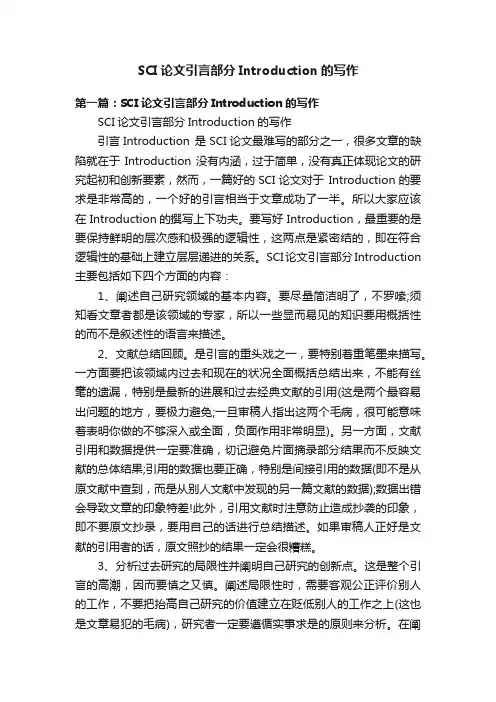
SCI论文引言部分Introduction的写作第一篇:SCI论文引言部分Introduction的写作SCI论文引言部分Introduction的写作引言Introduction 是SCI论文最难写的部分之一,很多文章的缺陷就在于Introduction没有内涵,过于简单,没有真正体现论文的研究起初和创新要素,然而,一篇好的SCI论文对于Introduction的要求是非常高的,一个好的引言相当于文章成功了一半。
所以大家应该在 Introduction的撰写上下功夫。
要写好 Introduction,最重要的是要保持鲜明的层次感和极强的逻辑性,这两点是紧密结的,即在符合逻辑性的基础上建立层层递进的关系。
SCI论文引言部分Introduction 主要包括如下四个方面的内容:1、阐述自己研究领域的基本内容。
要尽量简洁明了,不罗嗦;须知看文章者都是该领域的专家,所以一些显而易见的知识要用概括性的而不是叙述性的语言来描述。
2、文献总结回顾。
是引言的重头戏之一,要特别着重笔墨来描写。
一方面要把该领域内过去和现在的状况全面概括总结出来,不能有丝毫的遗漏,特别是最新的进展和过去经典文献的引用(这是两个最容易出问题的地方,要极力避免;一旦审稿人指出这两个毛病,很可能意味着表明你做的不够深入或全面,负面作用非常明显)。
另一方面,文献引用和数据提供一定要准确,切记避免片面摘录部分结果而不反映文献的总体结果;引用的数据也要正确,特别是间接引用的数据(即不是从原文献中查到,而是从别人文献中发现的另一篇文献的数据);数据出错会导致文章的印象特差!此外,引用文献时注意防止造成抄袭的印象,即不要原文抄录,要用自己的话进行总结描述。
如果审稿人正好是文献的引用者的话,原文照抄的结果一定会很糟糕。
3、分析过去研究的局限性并阐明自己研究的创新点。
这是整个引言的高潮,因而要慎之又慎。
阐述局限性时,需要客观公正评价别人的工作,不要把抬高自己研究的价值建立在贬低别人的工作之上(这也是文章易犯的毛病),研究者一定要遵循实事求是的原则来分析。
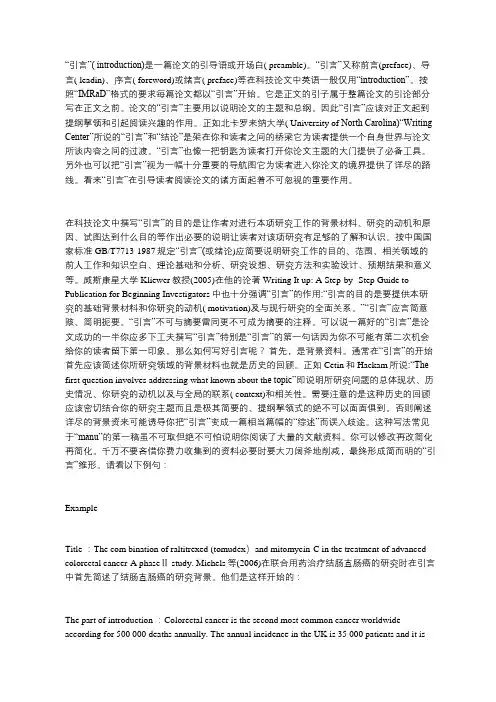
“引言”( introduction)是一篇论文的引导语或开场白( preamble)。
“引言”又称前言(preface)、导言( leadin)、序言( foreword)或绪言( preface)等在科技论文中英语一般仅用“introduction”。
按照“IMRaD”格式的要求每篇论文都以“引言”开始。
它是正文的引子属于整篇论文的引论部分写在正文之前。
论文的“引言”主要用以说明论文的主题和总纲。
因此“引言”应该对正文起到提纲挈领和引起阅读兴趣的作用。
正如北卡罗来纳大学( University of North Carolina)“Writing Center”所说的“引言”和“结论”是架在你和读者之间的桥梁它为读者提供一个自身世界与论文所谈内容之间的过渡。
“引言”也像一把钥匙为读者打开你论文主题的大门提供了必备工具。
另外也可以把“引言”视为一幅十分重要的导航图它为读者进入你论文的境界提供了详尽的路线。
看来“引言”在引导读者阅读论文的诸方面起着不可忽视的重要作用。
在科技论文中撰写“引言”的目的是让作者对进行本项研究工作的背景材料、研究的动机和原因、试图达到什么目的等作出必要的说明让读者对该项研究有足够的了解和认识。
按中国国家标准GB/T7713-1987规定“引言”(或绪论)应简要说明研究工作的目的、范围、相关领域的前人工作和知识空白、理论基础和分析、研究设想、研究方法和实验设计、预期结果和意义等。
威斯康星大学Kliewer教授(2005)在他的论著Writing It up: A Step-by- Step Guide to Publication for Beginning Investigators中也十分强调“引言”的作用:“引言的目的是要提供本研究的基础背景材料和你研究的动机( motivation)及与现行研究的全面关系。
”“引言”应言简意赅、简明扼要。
“引言”不可与摘要雷同更不可成为摘要的注释。

sci引言的最后一段摘要:一、引言部分1.背景介绍2.研究目的与意义3.研究方法与框架二、文献综述部分1.国内外相关研究概述2.研究现状与不足3.本文的创新点与贡献三、主体部分1.理论模型构建2.实证研究设计3.数据来源与处理4.结果分析与讨论四、结论与启示部分1.研究结论总结2.研究局限与不足3.对实践的意义与启示4.未来研究方向与建议正文:随着科技的不断发展,各行各业都对科学研究产生了浓厚的兴趣。
科学研究为我们提供了丰富的知识体系,指导着社会实践的发展。
在本文中,我们将重点关注sci 引言的最后一段,探讨其撰写方法与要点。
一、引言部分1.背景介绍在撰写sci 引言的最后一段时,首先需要对研究背景进行简要介绍。
这一部分可以包括研究领域的现状、存在的问题以及研究的重要性等。
背景介绍的目的是为了使读者对研究主题有一个初步的了解,激发他们对后续内容产生兴趣。
2.研究目的与意义在这一部分,我们需要明确研究的目标和意义。
研究目的应当具有明确性、可行性和合理性,能够指导整个研究的过程。
同时,研究意义也需要突出研究的价值,包括理论贡献和实践意义。
3.研究方法与框架在引言的最后一段,我们需要简要介绍研究的方法和框架。
这包括研究采用的理论基础、研究设计、数据来源等。
这部分的目的是为了让读者了解研究的基本思路,并为后续内容的阐述提供便利。
二、文献综述部分1.国内外相关研究概述在这一部分,我们需要对国内外关于研究主题的相关研究进行综述。
这包括历史发展、研究现状以及存在的问题等。
文献综述的目的是为了展示研究的广度和深度,为后续的实证研究奠定基础。
2.研究现状与不足在文献综述的基础上,我们需要指出当前研究的现状以及存在的不足。
这有助于突出本文研究的创新点和价值,为后续的研究提供动力。
3.本文的创新点与贡献在这一部分,我们需要阐述本文的创新点和贡献。
这可以是研究方法、数据来源、理论模型等方面的创新,也可以是对于现有研究不足的补充和完善。
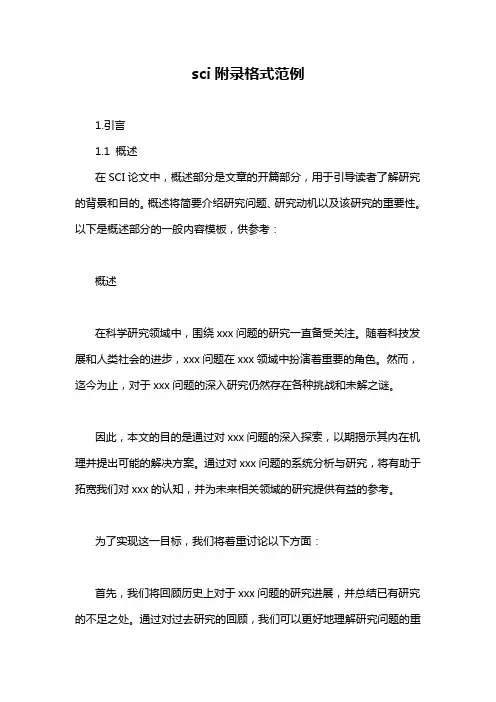
sci附录格式范例1.引言1.1 概述在SCI论文中,概述部分是文章的开篇部分,用于引导读者了解研究的背景和目的。
概述将简要介绍研究问题、研究动机以及该研究的重要性。
以下是概述部分的一般内容模板,供参考:概述在科学研究领域中,围绕xxx问题的研究一直备受关注。
随着科技发展和人类社会的进步,xxx问题在xxx领域中扮演着重要的角色。
然而,迄今为止,对于xxx问题的深入研究仍然存在各种挑战和未解之谜。
因此,本文的目的是通过对xxx问题的深入探索,以期揭示其内在机理并提出可能的解决方案。
通过对xxx问题的系统分析与研究,将有助于拓宽我们对xxx的认知,并为未来相关领域的研究提供有益的参考。
为了实现这一目标,我们将着重讨论以下方面:首先,我们将回顾历史上对于xxx问题的研究进展,并总结已有研究的不足之处。
通过对过去研究的回顾,我们可以更好地理解研究问题的重要性和复杂性。
其次,我们将详细介绍本文的方法和实验设计。
我们将采用xxx方法和技术来解决xxx问题,并结合大规模数据和有力的实验证据进行分析。
通过严格的实施实验和科学的数据分析,我们期望能够得出准确可靠的结论。
最后,我们将对本文的结构进行简要概述。
本文将分为以下几个部分:第二部分将介绍xxx问题的背景及其相关研究。
第三部分将详细介绍研究方法和实验设计。
第四部分将展示实验结果和数据分析。
最后,第五部分将对实验结果进行讨论,并提出未来的研究展望。
通过对xxx问题的深入研究,我们期望能够为相关领域的学者和研究人员提供更多的见解和启发,并为xxx问题的解决做出积极的贡献。
以上是概述部分的内容。
根据具体研究内容和论文结构的需要,您可以对模板进行适当修改和调整,以使其更符合您的研究内容和写作风格。
1.2 文章结构文章结构是指文章的整体框架和组织方式,在写作过程中对整篇文章进行了合理的分章节和段落,使读者更易于理解和阅读。
本文将按照以下结构进行论述:引言部分、正文部分和结论部分。
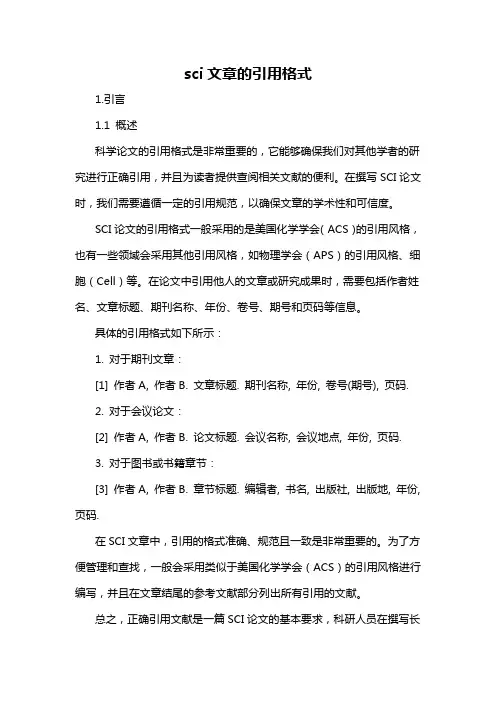
sci文章的引用格式1.引言1.1 概述科学论文的引用格式是非常重要的,它能够确保我们对其他学者的研究进行正确引用,并且为读者提供查阅相关文献的便利。
在撰写SCI论文时,我们需要遵循一定的引用规范,以确保文章的学术性和可信度。
SCI论文的引用格式一般采用的是美国化学学会(ACS)的引用风格,也有一些领域会采用其他引用风格,如物理学会(APS)的引用风格、细胞(Cell)等。
在论文中引用他人的文章或研究成果时,需要包括作者姓名、文章标题、期刊名称、年份、卷号、期号和页码等信息。
具体的引用格式如下所示:1. 对于期刊文章:[1] 作者A, 作者B. 文章标题. 期刊名称, 年份, 卷号(期号), 页码.2. 对于会议论文:[2] 作者A, 作者B. 论文标题. 会议名称, 会议地点, 年份, 页码.3. 对于图书或书籍章节:[3] 作者A, 作者B. 章节标题. 编辑者, 书名, 出版社, 出版地, 年份, 页码.在SCI文章中,引用的格式准确、规范且一致是非常重要的。
为了方便管理和查找,一般会采用类似于美国化学学会(ACS)的引用风格进行编写,并且在文章结尾的参考文献部分列出所有引用的文献。
总之,正确引用文献是一篇SCI论文的基本要求,科研人员在撰写长文时一定要注意引用规范,以确保文章的学术性和可信度,并且保持引用格式的一致性。
1.2文章结构1.2 文章结构本文主要讨论SCI文章的引用格式。
为了更好地组织和展示文中的内容,本文将按照以下结构进行描述。
1.2.1 引言在引言部分,我们将概述本文的内容并说明研究的背景和意义。
通过指出SCI文章的引用格式在学术研究中的重要性,我们将引起读者的兴趣。
1.2.2 文章目录在文章目录部分,我们将提供本文的整体框架,以便读者了解我们接下来将涉及的各个部分。
1.2.3 正文正文是本文的主要内容部分,将涵盖SCI文章的引用格式的详细说明。
我们将分成多个要点进行讨论,以便读者更好地理解和应用SCI文章的引用格式。
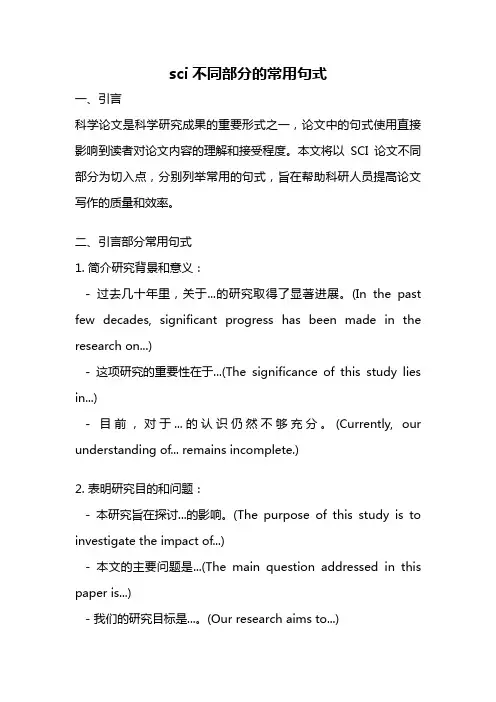
sci不同部分的常用句式一、引言科学论文是科学研究成果的重要形式之一,论文中的句式使用直接影响到读者对论文内容的理解和接受程度。
本文将以SCI论文不同部分为切入点,分别列举常用的句式,旨在帮助科研人员提高论文写作的质量和效率。
二、引言部分常用句式1. 简介研究背景和意义:- 过去几十年里,关于...的研究取得了显著进展。
(In the past few decades, significant progress has been made in the research on...)- 这项研究的重要性在于...(The significance of this study lies in...)- 目前,对于...的认识仍然不够充分。
(Currently, our understanding of... remains incomplete.)2. 表明研究目的和问题:- 本研究旨在探讨...的影响。
(The purpose of this study is to investigate the impact of...)- 本文的主要问题是...(The main question addressed in this paper is...)- 我们的研究目标是...。
(Our research aims to...)3. 介绍研究方法和实验设计:- 采用了...的方法进行实验。
(The experiment was conducted using the method of...)- 在实验设计中,我们考虑了...的因素。
(In the experimental design, we took into account the factors of...)- 为了验证我们的假设,我们采用了...的实验方案。
(To test our hypothesis, we employed an experimental design of...)三、方法部分常用句式1. 描述实验对象或样本:- 本研究选择了...作为研究对象。

sci语言证明模板1.引言1.1 概述概述部分的内容可以写为:在科学研究和学术写作中,SCI(Science Citation Index)语言证明模板是一种常用的写作工具,可用于撰写科学论文、学术报告以及学术研究项目。
SCI语言证明模板的主要目的是通过清晰、准确地表达研究的目的、方法、结果和结论,使读者能够全面了解并复现研究的过程和结果。
SCI语言证明模板的结构相对固定,通常包括引言、正文和结论三个部分。
引言部分主要概述研究的背景和意义,引出研究的问题,并概括阐述研究的目的和意义。
正文部分将具体介绍研究的要点、方法和实验结果,并分析解释结果的意义和影响。
结论部分则是对整个研究进行总结,并提出可能的展望和建议。
本文将详细介绍SCI语言证明模板的各个部分的写作要点,并针对每个部分提供一些实用的写作技巧。
希望通过本文的阐述,读者能够掌握SCI 语言证明模板的应用方法,进一步提升科学写作的能力,使自己的研究成果更具可读性和可信度。
1.2文章结构文章结构是指文章整体组织的方式和框架,它有助于读者理解文章的逻辑性和条理性。
在本文中,文章结构包括引言、正文和结论三个部分。
引言部分旨在引导读者进入主题,并对文章进行概述。
在本文的引言部分,我们将概述本文的主要内容、目的和结构。
正文部分是文章的核心,包括一系列的要点。
在本文的正文部分,我们将介绍两个要点。
每个要点将会以一个小节的形式呈现,便于读者理解和阅读。
结论部分是对整篇文章进行总结,并对未来的研究或发展进行展望。
在本文的结论部分,我们将对前文的要点进行总结,并对相关研究领域的未来发展方向进行展望。
通过以上结构,本文将帮助读者全面了解SCI语言证明模板,并提供指导和建议。
在"sci语言证明模板"这篇长文中,1.3 目的部分旨在明确文章的目标和意义。
其内容可以按照以下方式进行编写:目的:本文的目的是提供一个科学语言证明模板,以帮助读者正确、有效地撰写科学论文。

科学引用格式(SCI的References格式)1.引言科学引用格式(SCI)是一种用于在学术出版物中引用参考文献的标准格式。
SCI格式由美国化学学会(ACS)领导的一组学术出版组织共同制定,目的是为了使学术论文的引用标准化、规范化,方便读者查找和理解参考文献的信息。
2.SCI格式的特点SCI格式的引用特点主要包括以下几点:(1)作者姓氏在前,名字在后,用逗号隔开,而非中文的姓在前,名在后的格式。
(2)标题使用“斜体”,刊物名称用“正体”。
(3)引用的序号要用方括号括起来,而非使用括号。
这些规范的要求使得学术论文的引用信息更加清晰、规范,方便读者查找和理解引用的参考文献。
3.SCI格式的应用范围SCI格式广泛应用于自然科学和工程技术领域的学术出版物中,如物理学、化学、生物学、材料科学等领域。
SCI格式的引用标准被认为是国际上学术界最权威的引用标准之一,因此在相关领域的学术出版物中广泛使用。
4.SCI格式的引用要求SCI格式的引用要求非常严格,引用时需要按照一定的格式和顺序来列出参考文献的信息。
一般来说,SCI格式的引用要求包括以下内容:(1)作者的尊称(姓氏在前,名字在后)。
(2)文献的标题(使用斜体)。
(3)刊物的名称(使用正体)。
(4)刊物的卷号、期号和页码。
(5)出版年份。
5.SCI格式的示例以下是一篇使用SCI格式引用的参考文献示例:[1] Smith, J. A. The effects of climate change on marine ecosystems. Nature, 2015, 523(7561): 418-420.上面的引用示例中,方括号内的数字1表示引用的序号,Smith, J. A.是作者的尊称,The effects of climate change on marine ecosystems是文献的标题,Nature是刊物的名称,2015是出版年份,523是卷号,7561是期号,418-420是页码。
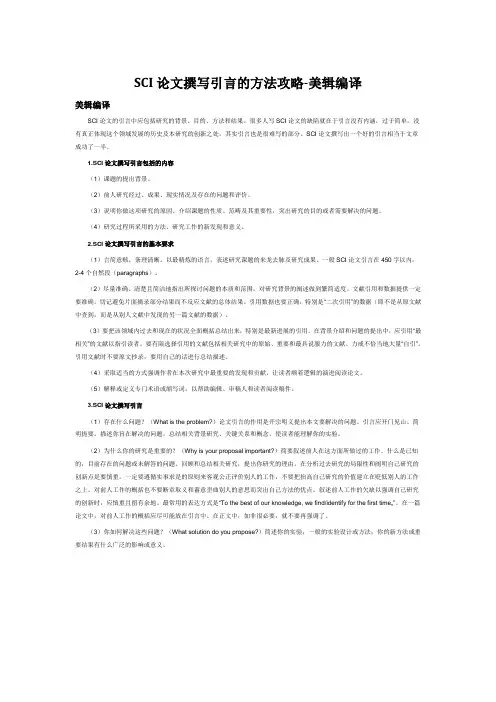
SCI论文撰写引言的方法攻略-美辑编译美辑编译SCI论文的引言中应包括研究的背景、目的、方法和结果。
很多人写SCI论文的缺陷就在于引言没有内涵,过于简单,没有真正体现这个领域发展的历史及本研究的创新之处。
其实引言也是很难写的部分。
SCI论文撰写出一个好的引言相当于文章成功了一半。
1.SCI论文撰写引言包括的内容(1)课题的提出背景。
(2)前人研究经过、成果、现实情况及存在的问题和评价。
(3)说明你做这项研究的原因。
介绍课题的性质、范畴及其重要性,突出研究的目的或者需要解决的问题。
(4)研究过程所采用的方法、研究工作的新发现和意义。
2.SCI论文撰写引言的基本要求(1)言简意赅,条理清晰。
以最精炼的语言,表述研究课题的来龙去脉及研究成果。
一般SCI论文引言在450字以内,2-4个自然段(paragraphs)。
(2)尽量准确、清楚且简洁地指出所探讨问题的本质和范围,对研究背景的阐述做到繁简适度。
文献引用和数据提供一定要准确,切记避免片面摘录部分结果而不反应文献的总体结果。
引用数据也要正确,特别是“二次引用”的数据(即不是从原文献中查到,而是从别人文献中发现的另一篇文献的数据)。
(3)要把该领域内过去和现在的状况全面概括总结出来,特别是最新进展的引用。
在背景介绍和问题的提出中,应引用“最相关”的文献以指引读者。
要有限选择引用的文献包括相关研究中的原始、重要和最具说服力的文献。
力戒不恰当地大量“自引”。
引用文献时不要原文抄录,要用自己的话进行总结描述。
(4)采取适当的方式强调作者在本次研究中最重要的发现和贡献,让读者顺着逻辑的演进阅读论文。
(5)解释或定义专门术语或缩写词,以帮助编辑、审稿人和读者阅读稿件。
3.SCI论文撰写引言(1)存在什么问题?(What is the problem?)论文引言的作用是开宗明义提出本文要解决的问题。
引言应开门见山、简明扼要。
描述你旨在解决的问题。
总结相关背景研究、关键关系和概念,使读者能理解你的实验。
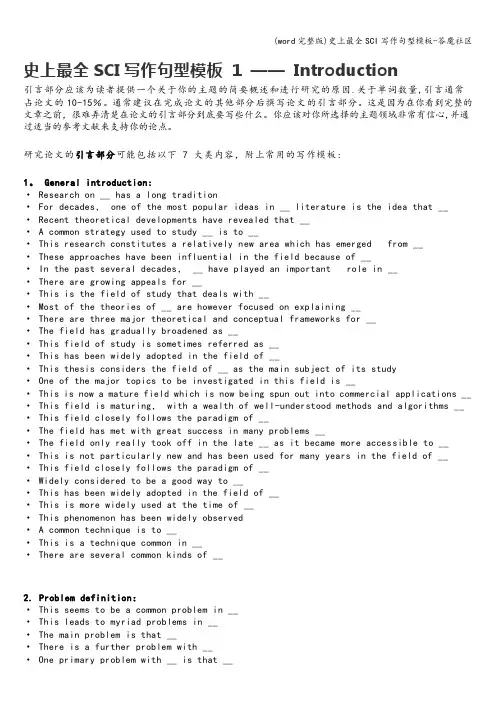
史上最全SCI写作句型模板1 ——Introduction引言部分应该为读者提供一个关于你的主题的简要概述和进行研究的原因.关于单词数量,引言通常占论文的10-15%。
通常建议在完成论文的其他部分后撰写论文的引言部分。
这是因为在你看到完整的文章之前,很难弄清楚在论文的引言部分到底要写些什么。
你应该对你所选择的主题领域非常有信心,并通过适当的参考文献来支持你的论点。
研究论文的引言部分可能包括以下 7 大类内容,附上常用的写作模板:1。
General introduction:· Research on __ has a long tradition· For decades, one of the most popular ideas in __ literature is the idea that __· Recent theoretical developments have revealed that __· A common strategy used to study __ is to __· This research constitutes a relatively new area which has emerged from __· These approaches have been influential in the field because of __· In the past several decades, __ have played an important role in __· There are growing appeals for __· This is the field of study that deals with __· Most of the theories of __ are however focused on explaining __· There are three major theoretical and conceptual frameworks for __· The field has gradually broadened as __· This field of study is sometimes referred as __· This has been widely adopted in the field of __· This thesis considers the field of __ as the main subject of its study· One of the major topics to be investigated in this field is __· This is now a mature field which is now being spun out into commercial applications __· This field is maturing, with a wealth of well-understood methods and algorithms __· This field closely follows the paradigm of __· The field has met with great success in many problems __· The field only really took off in the late __ as it became more accessible to __· This is not particularly new and has been used for many years in the field of __· This field closely follows the paradigm of __· Widely considered to be a good way to __· This has been widely adopted in the field of __· This is more widely used at the time of __· This phenomenon has been widely observed· A common technique is to __· This is a technique common in __· There are several common kinds of __2. Problem definition:· This seems to be a common problem in __· This leads to myriad problems in __· The main problem is that __· There is a further problem with __· One primary problem with __ is that __· The methods are not without their problems as will be discussed in __· The foremost problems are the facts that __· This makes up for the problem of __· This seems to be a common problem in __· This is a complex problem and to simplify it requires __· A challenging problem which arises in this domain is __· These problems are difficult to handle __· This is typically a complex problem __· A well—known problem with __ is that it does not take into account the __· One of the problems is that it considers only the __· The key problem with this technique is __· It is usually an ill—posed problem in the case of __· This problem is well—posed and does not require to impose __· This appears as a more straightforward problem compared to the __· This turns out to be even more problematic because __· The problem with such an implementation is that __· This poses some problems when carrying out the __· This problem has attracted more attention in the field of __· This is a basic chicken—and—egg problem because __· Unfortunately, this approach results in problems related to __· These constraints make the problem difficult to __· Most of the research in this field is aimed at solving this problem。
1. Introduce the Research Area1.1. Identify the research area1.2. Establish the importance of the research area1.3. Provide essential background information about the research area2. Identify a Gap (or Gaps)3. Fill the Gap3.1. Introduce the current work3.2. Preview key findings of the current work (optional)The first move, with three submoves, has the broad purpose of describing the general resarch area. Submove 1.1 identifies the research topic, and submove 1.2 stresses its importance. Together, these two submoves are frequently accomplished in the first few sentences of the paper. Note that only the general topic is mentioned at this point, not the specific work that is presented in the paper. Submove 1.3 is where authors summarize essential works in the field and situate the current work in its appropriate context. This submove does not provide an exhaustive review of the literature but rather includes "sound bites" that alert readers to works that critically influenced the current work or led to fundamental knowledge in the field. The entire move is usually accomplished in a few paragraphs, with most attention devoted to submove 1.3. All three submoves are strengthened by citations to the literature. Works by other authors are cited as well as previous, relevant works by the current authors.The second move in the Introduction section (Identify a Gap) shifts the reader's attention from what has been done (or learned or understood) to what still needs to be done (or learned or understood). The essence of this move is capyured in the sentence, "Although much is known about X, little is known about Y." Of course, to correctly identify a gap, the authors must have throughly reviewed the literature; hence, cotations to the literature are common in this move, too.After a gap has been identified, the third and final move of the Introduction section is to fill the gap. This move typically comprises a short paragraph at the end of the Introduction and begins with a phrase like "In this paper, we..." At last, the authors can refer to the current work, and many use the personal pronoun we to accomplish this task. The authors give a short description of the current work (typically a few sentences), highlighting how the work fills the identified gas (submove 3.1). The Introduction can end here, or the authors can elect to preview their principal findings (submove 3.2). If the authors do the latter, care must be taken not to repeat sentences verbatim that appear elsewhere in the paper.以上说了写引言的“基本公式”。
英国论文中Introduction的六个层次“公式”有小伙伴们觉得英文论文写作不难,但却总是拿不到高分,非常奇怪。
其实是大家把它想简单了,就好比I n t r o d u c t i o n部分,看似简单,其实要写好真的很难。
引言(I n t r o d u c t i o n)作为对论文的内容和结构的概括可以遵循一定的“公式”,也就是说引言(I n t r o d u c t i o n)可以被解构为6个层次的内容,下面就给大家讲解一下。
六个层次“公式”即:背景;现状及分歧;目的;原因;意义;o u t l i n e。
具体写作层次如下:第一层次描述这个所选t o p ic的背景和重要性背景写作的主要目的是引出所选t o p ic以往的研究文献也及该课题以往的研究观点,因此在写作上虽然会比较宏观一些,但一定要紧密联系t o p i c,可以用一两句话带过。
举个例子:“O n e o f t h e m o s t c o m m o n d i l e m m a s f a c i n g m a n y s t u d e n t s i nt h e U n i t e d K i n g d o m i n r e c e n t y e a r s h a s b e e n t h e q u e s t i o n o fw h e t h e r o r n o t t o t a k e a p a r t-t i m e j o b.R i s i n g t u i t i o n f e e s a n d l i v i n g e x p e n s e s m a k e l i f e v e r y d i f f i c u l t f o r s t u d e n t s w h o d o n o t b e n e f i t f ro m t h e f i n a n c i a l s u p p o r t o f t h e i r p a r e n t s o r o t h e rs p o n s o r s.I n o r d e r t o s u r v i v e,t h o u s a n d s o f s t u d e n t s t a k e o u ts e v e r a l l o a n s a n d i n c u r s e r i o u s d e b t i n t h e c o u r s e o f t h e i r y e a r sa t u n i v e r s i t y.H o w e v e r,o t h e r s a t t e m p t t o e a s e t h e f i n a n c i a lb u r d e n o f f u l l-t i m e s t u d y b y f i n d i n g a p a r t-t i m e j o b.”介绍该课题目前的研究现状以及存在的分歧在这一部分不仅要对前人的研究做简要说明,还要总结这些文献的g a p,也就是目前的研究中都存在哪些争议,或者没有涉及到的研究。
一篇完整的医学SCI论文基本格式分析一篇完整的SCI论文应该包含title,abstract,keywords,text,acknowledgement,references,有图和表的还应该包括legends。
下面笔者来谈谈每项所包含的一些具体内容:1.标题(title)医学论文题目要求命题既能概括全文内容,又能引人注目,便于记忆和引用,做到恰当、确切、简短、鲜明,起到一种画龙点睛的作用,以引起读(编)者的注意与兴趣。
通常标题所在页叫标题页(title page),一般由以下几个部分组成:(1)完整标题(full title)。
(2)小标题或眉题(running title/running head):有些期刊不需要填写这一项。
(3)作者署名(author name):医学论文署名要用真名而不用笔名。
署名不可过多,应本着实事求是的原则,必须参加全部或部分主要工作,或参加文章撰写,对文章内容负责的人。
署名次序应按贡献大小依次排列。
(4)作者单位(author affiliation)。
(5)通讯作者及其单位、邮箱、电话、传真等(corresponding author)。
有的期刊可能要求在标题页写出摘要字数,正文字数,或插图和表格数量,或标明是否有基金资助,是否存在利益冲突,等等。
2.摘要(abstract)摘要是正文的高度浓缩,是医学论文内容的简短陈述,便于读者了解全文的要点,便于做文摘和检索。
因此,摘要应力求简明扼要,字数一般为150~300字左右,如是特殊情况字数可以略多。
摘要可以独立使用,不过简亦不过繁,不要一般的套话空话。
摘要最常见的为一段式或结构式两种,结构式摘要(structured abstract)一般从以下四个方面入手:(1)背景或目的(background/obxxxxjective);(2)方法(methods);(3)结果(results);(4)结论(conclusions)。
科研方法纯干货!SCI论文中Introduction的不同部分不会写?我为你总结201个句式征稿:二语写作现在整个科研社会,对于SCI的要求是越来越高了。
我们学校的博士生要求两篇二区的SCI,才能达到毕业要求。
但是说实话,我们学院很多老师都没发过二区的文章。
而且最近我也听说以前读书的学校,现在硕士生也要求SCI才能毕业,对于别的专业来说可能不难,但是对于我这个领域来说,要求确实很高了。
所以大家SCI写作现在是越来越重视了。
SCI写作难不难?当然难。
这种难不光是内容上的,还包括语言上的。
一般国内学者投稿不会投中文SCI期刊,所以基本上都是英文的。
有时候就算你内容特别好,你想把它用地道的英语表达出来也不容易。
不过再难的东西,我们也可以试着去寻找一下它的规律,SCI论文写作的表达肯定也是有规律可寻的。
我平时就喜欢研究这些,为了让你们写文章能更轻松一些,我就把我总结的一些表达的规律告诉你们,你们拿到之后可以直接使用,稍微调整一下个别单词,也不用担心重复问题。
因为一篇SCI论文可以分成很多部分,每一部分的语言表达又是不一样的,今天我就先给大家介绍一下Introduction部分,Introduction部分也分成好几块,我就挨个给大家介绍一下。
废话不多说了,准备好了我们就开始吧。
简单地说一下,国内外已经有很多人在做相关研究了。
The literature is reviewed to examine available methods that could be used to __ (...)A review of the literature conducted shows that there are no suitable methods already for __ (...)The literature was reviewed for possible methods to __ (...) An up-to-date overview of methods used for __ is presented. (...) It is important to have some awareness of current issues hig hlighted in the literature. (...)This section outlines the existing methods available in the literature for __ (...)This section discusses the literature in the field. (...)The literature review pays special attention to the class of m ethods central to our research. (...)Different solutions available in the literature to solve this pr oblem have been reviewed. (...)These citations are related to the work presented in this the sis. (...)The methods in the literature that are the most immediately relevant are reviewed. (. ..)An overview of the previous and current attempts to develo p this method is given. (...)A good overview of the research in this area is provided her e. (...)The literature review describes the previous and current atte mpts to address this issue. (...)The review provides details of the strengths and weaknesses of existing methods in the literature. (...)A review of the current state-of-the-art in the field is given. (...)A considerable amount of review of previous work in the su bject area is given below. (...)The aim of this review is to compare state-of-the-art techniques. (...)Some of the essential or seminal developments in this area are reviewed. (...)This section reviews some of the most pertinent papers on _ _ (...)The major areas of research in this area are explained. (...)This has been of interest for a considerable period, ranging from the early __ (...)There exists a very extensive literature on the topic of __ (...) In the literature, these have been extensively investigated in an attempt to __ (...)There is also a large body of work in this area considering __ (...)This is widely reported and extensively explored in the litera ture by __ (...)These have been important topics of study in the literature f or many years. (...)This has been studied by several authors in the literature. (...) Within the literature,there has been much research surrounding concepts of __ (...) There is a body of research that has focused extensively on __ (...)There are a broad interest and literature base for __ (...)Over the last x years, much research has examined __ (...)Research in this field is dominated by providing solutions to this problem. (...)This problem has attracted considerable attention in the lite rature. (...)An enormous amount of work has been carried out in this area. (...)With respect to this specific subject, there has also been sig nificant work. (...)These issues are well covered in the literature related to this subject. (...)There is a large amount of literature on this research. (...)There has been a lot of work on the __ (...)The literature on this topic is plentiful and easy to find. (...) There arefew examples available in the literature on this subject. (...) These are well studied and documented in the literature. (...) There exist quite a lot of discussions in the literature as to __ (...)A large body of work has been completed using these meth ods. (...)These important issues have been largely discussed in the li terature. (...)This has been much investigated in literature. (...)This has been extensively discussed in the literature. (...)There is a large body of literature surrounding the __ (...)This subject has been extensively explored in the literature. (...)Several studies have explored the effects of __ (...)There have been several attempts to __ (...)There have been multiple previous attempts to __ (...)A number of studies have examined the __ (...)Several investigators have probed if __ (...)In the last decade, various studies have determined the effe ct of __ (...)In order to test this concept, a number of studies have investigated the __ (...)There have been a number of studies that have investigated the effectiveness of __ (...)Several studies have been published examining the impact of __ (...)A number of studies and reviews have been undertaken to explore the __ (...)A significant variety of designs of this system is found in the literature. (...)A multitude of such approaches has been presented in the l iterature. (...)如果是具体到现在有人在做这个研究。
sci引言的最后一段
(实用版)
目录
1.引言的重要性
2.SCI 引言的特殊性
3.SCI 引言的最后一段的作用
4.如何撰写 SCI 引言的最后一段
正文
在撰写 SCI 论文时,引言部分具有举足轻重的地位。
它不仅是整篇论文的开篇,还是审稿人和读者判断论文质量的关键部分。
引言的撰写要求言简意赅、清晰明了,能够准确概括论文的研究背景、目的和主要内容。
而 SCI 引言的特殊性在于,它需要遵循国际学术规范和表达方式,以英文撰写,并体现出论文的创新性和学术价值。
在 SCI 引言的最后一段,通常需要总结前文的内容,并明确指出研究的目的、方法和预期结果。
这一部分的撰写对整篇论文的质量有着至关重要的影响。
因此,我们应该如何撰写 SCI 引言的最后一段呢?
首先,回顾研究背景和问题。
在这一部分,需要简洁明了地介绍研究背景,概括目前存在的问题和研究的意义。
对于研究背景的描述,要尽量简练,避免冗长和复杂的表述。
其次,明确研究目的和方法。
在这一部分,要清晰地阐述研究的具体目的和所采用的方法。
对于研究目的的描述,要突出创新性和实用性,以引起审稿人和读者的兴趣。
对于研究方法的描述,要简明扼要,突出关键步骤和实验设计。
最后,概述预期结果和意义。
在这一部分,需要对预期结果进行合理的预测,并阐述研究成果对学术界和实际应用的贡献。
对于预期结果的描
述,要具有前瞻性和科学性,避免过于乐观或悲观的估计。
总之,在撰写 SCI 引言的最后一段时,我们需要注意以上几个方面的要求,确保引言的完整性和科学性。
SCI引⾔和讨论⼀般多少字引⾔和讨论是SCI论⽂内容组成部分。
撰写时,字数要求是多少,备受作者关注,以免编写的字数太多或太少,影响论⽂发表的时间以及成功率。
那么,SCI引⾔和讨论⼀般多少字?1、SCI引⾔字数SCI引⾔是论⽂的开头,起着引导读者的作⽤,⼀般在450字以内,2-4个⾃然段。
引⾔是SCI论⽂最难写的部分之⼀,要求⾮常⾼,写好前⾔,最重要的是要保持鲜明的层次感和极强的逻辑性,⼀旦写好,相当于SCI论⽂成功了⼀半。
⼀般来说,SCI论⽂引⾔,要阐述⾃⼰研究领域的基本内容,以及⽂献总结回顾。
具体来说,你先要写你所研究问题的历史,包含重要性和必要性,研究进展,前⼈的⼯作,遇到了什么问题,进⽽推出你的研究动机,使读者明⽩你研究问题的来龙去脉。
交待清楚后,说明你解决了什么问题,进⽽引出下⽂。
2、SCI讨论字数讨论是SCI论⽂的精髓,是你对结果进⾏分析,提炼出其研究的意义和价值。
不同的⽂章,讨论字数不同,没有明确的规定,可能⼏千字,也可能上万字。
讨论是SCI论⽂最难写的另⼀部分,在很⼤程度上可以决定了SCI论⽂能不能成功发表。
写好讨论,可以体现作者所研究问题的⼴度和深度,通常包括以下⼏个部分:(1)重申你的结果,并探讨是否符合学科规律,并进⾏深⼊分析;(2)多维度分析结果的不同,⽐较优劣,与其他⼈⼯作的差异;(3)突出你⼯作的亮点和新颖性,强调创新点;(4)指出⾃⼰⼯作的不⾜和局限性,并提出改进⽅案,为以后实验打基础;(5)可以适当描述⼀下future work,提出⼀些新的问题和研究⽅向。
SCI引⾔和讨论⼀般多少字?本⽂关于该问题的介绍先到这⾥。
了解SCI论⽂发表上的更多问题,可以咨询知实学术⽹的在线编辑。
本⽂由知实学术⽹⾸发,⼀个权威专业的学术论⽂发表知识⽹。
⽂章名称:SCI引⾔和讨论⼀般多少字。
良好的开头是成功的一半。
如果能写好引言部分,作者对于审稿人来说就有置信度(credibility)和好的第一印象;而如果引言部分没有写好,整篇文章都会被拖累。
写引言部分的核心目的和基本功能(底线)是向读者和审稿人说清楚“我为什么要做这个研究”,能够自圆其说。
而为了达到这个目的,有一个“基本公式”:首先说这个课题引起广泛兴趣,有重要的理论和应用价值;其次说谁谁谁做了什么,他们发现了什么,但是什么什么还不清楚,效果还不理想。
再次说有鉴于存在的问题,我们在本文中用了什么方法做了什么,得到什么结果。
老练的作者写引言部分都是按照这个思路去写的,用三、四段话就能把引言部分给构建好,每一段话功能突出、点到为止。
相反,不老练的作者写引言部分显得没有章法,沿着“意识流”,想到什么地方说到什么地方,每一段话没有功能也没有结构。
为什么有的文章眉毛胡子一把抓?为什么有的文章读也读不懂?是因为根本就没有按照“公式”去写!也许有的人会说我误导研究生,但是事实上这种对科研写作有益的“八股文”被写进正宗教科书呢!2008年牛津大学出版社出版了一本Write Like a Chemist,里面说到表演喜剧、电视里面做卖车的广告,都是有一定套路的,不按照套路出牌就吸引不了观众,就没有人来看戏、买车。
同理,书中介绍了写引言部分的“公式”:1. Introduce the Research Area1.1. Identify the research area1.2. Establish the importance of the research area1.3. Provide essential background information about the research area2. Identify a Gap (or Gaps)3. Fill the Gap3.1. Introduce the current work3.2. Preview key findings of the current work (optional)The first move, with three submoves, has the broad purpose of describing the general resarch area. Submove 1.1 identifies the research topic, and submove 1.2 stresses its importance. Together, these two submoves are frequently accomplished in the first few sentences of the paper. Note that only the general topic is mentioned at this point, not the specific workthat is presented in the paper. Submove 1.3 is where authors summarize essential works in the field and situate the current work in its appropriate context. This submove does not provide an exhaustive review of the literature but rather includes "sound bites" that alert readers to works that critically influenced the current work or led to fundamental knowledge in the field. The entire move is usually accomplished in a few paragraphs, with most attention devoted to submove 1.3. All three submoves are strengthened by citations to the literature. Works by other authors are cited as well as previous, relevant works by the current authors.The second move in the Introduction section (Identify a Gap) shifts the reader's attention from what has been done (or learned or understood) to what still needs to be done (or learned or understood). The essence of this move is capyured in the sentence, "Although much is known about X, little is known about Y." Of course, to correctly identify a gap, the authors must have throughly reviewed the literature; hence, cotations to the literature are common in this move, too.After a gap has been identified, the third and final move of the Introduction section is to fill the gap. This move typically comprises a short paragraph at the end of the Introduction and begins with a phrase like "In this paper, we..." At last, the authors can refer to the current work, and many use the personal pronoun we to accomplish this task. The authors give a short description of the current work (typically a few sentences), highlighting how the work fills the identified gas (submove 3.1). The Introduction can end here, or the authors can elect to preview their principal findings (submove 3.2). If the authors do the latter, care must be taken not to repeat sentences verbatim that appear elsewhere in the paper.以上说了写引言的“基本公式”。
结合我自己的体会,写引言部分的注意事项为:1. 引言结构如“倒金字塔”,即从一个“宽泛的研究领域”到一个“本文要做的特定的东西”。
结构不能颠倒,而且“倒金字塔”的“基底”不能无限宽广,即:不能从漫无边际的地方说起。
比如写催化科研论文,如果有的人首先介绍说:“催化在国民生产中多么多么重要,80%的化工流程都有赖于催化。
氧化在催化中很重要。
选择氧化在氧化中很重要。
使用空气作为氧化剂的选择氧化很重要。
使用无毒催化剂的空气选择氧化很重要。
”,那么这样引言的开场白就扯得太远了,没有直奔主题。
2. 在介绍别人和自己做了什么前期工作时,要根据这一小部分(submove 1.3)的功能,有针对性、概括性地综述,不能“堆积材料”。
所谓“堆积材料”就是说引用每一篇文献时用了大量篇幅进行描述,没有概括出和本文有关的要点,而是把该文献的摘要抄了一遍。
还有的人写作时,为了引文献而引文献,比如说在介绍黄金催化剂时,说现在黄金催化剂有Au/ZrO2, Au/TiO2, Au/SnO2, Au/Fe2O3, Au/Al2O3, Au/ZnO, Au/CuO, Au/C...,每一个催化剂都随机引用了5条文献,洋洋洒洒40条文献,却只说明一件事情:各类黄金催化剂被广泛研究。
那么审稿人读了这句话就说,研究某种黄金催化剂的文献远远不止5篇,那么你引用这5篇的标准是什么呢?为什么不总的引用5篇综述来替代这洋洋洒洒40篇文献?3. 避免使用时髦语,避免滥用套话。
时髦语如“黄金催化剂的研究是当今催化研究皇冠上的钻石,是北极星”。
看到这样的话,审稿人就会举起大斧砍下来。
另外,避免滥用套话的意识就是说引言部分不能到处都是“什么什么课题引起广泛兴趣,在什么什么中有广泛应用”,如果每一段都这么说,什么一段出现几个这样的句子的话,就无趣了。
4. 指出课题组前文和本文的联系和区别。
回答既然前面已经发表过几篇文章了,为什么本文还是值得发表?既然已经发过一篇快报,现在为什么要发长文章?和前文相比,有哪些新方法、新内容、新理论?是否达到更好的应用效果?如果自己不写清楚这些东西,审稿人当然不会主动给作者回答这些问题的;而如果在引言部分写清楚这些东西,审稿人的思维就会根据这些东西来判断是否可信,往往在写审稿意见的时候也会把你写的理由复述一遍,说的确有新东西,建议发表。
5. 在引言部分的末尾建议用简练的话把本文的重要结果“预览”一下。
Ratnoff 在1981年说:Reading a scientific article isn't the same as reading a detective story. We want to know from the start that the butler did it.(见R.A. Day, B. Gastel. How to Write and Publish a Scientific Paper (6th Edition)。
但是注意不能使用大篇幅预览,不能把正文里面的信息(比如用XRD 做了什么,发现这个峰那个峰;用红外做了什么,发现这个峰那个峰)详细透露,一览无余。